- Products
- PoE Media Converters and Switches
- Ethernet & PoE Switches Product Selector
- Multi-Gigabit Ethernet and PoE Switches
- PoE PSE Commercial Switches
- PoE PSE Industrial Fiber Switches
- PoE Industrial Copper Extenders
- PoE Powered Media Converters
- PoE PSE Media Converters
- PoE Extenders & Injectors Product Selector
- Pluggable Transceivers Product Selector
- Single Pair PoE Products
- Product Lines
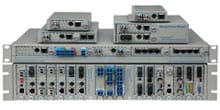
- iConverter Managed Multi-service Platform
- Copper to Fiber Media Converters
- Ethernet Media Converters
- 10 Gigabit Copper-to-Fiber
- 10/100/1000 Copper to 10 Gigabit Fiber
- 10/100/1000 Copper-to-Fiber with Integrated Management
- 10/100/1000 Industrial Copper-to-Fiber with Integrated Management
- 10/100/1000 Copper-to-Fiber with VLAN
- 10/100/1000 Dual Media Converter with VLAN
- Gigabit Copper-to-Fiber
- 10/100 Copper-to-Fiber with Integrated Management
- 10/100 Industrial Copper-to-Fiber with Integrated Management
- 10/100 Copper-to-Fiber with VLAN
- 10/100 Copper-to-Fiber
- Fast Ethernet Copper-to-Fiber
- Fast Ethernet Redundant Links
- 10Mbps Copper-to-Fiber
- 10Mbps Copper to Coax
- TDM Media Converters
- Serial Media Converters
- Ethernet Media Converters
- Fiber to Fiber Media Converters
- 10 Gigabit Fiber-to-Fiber Converter and Transponder
- 10 Gigabit Industrial Converter and Transponder
- SFP-to-SFP Fiber Converter and Transponder
- SFP-to-SFP Industrial Fiber Converter and Transponder
- Gigabit Fiber to-Fiber with 3 Rs
- 100/1000 Fiber-to-Fiber with 3 Rs
- Gigabit Fiber-to-Fiber
- Fast Ethernet Fiber-to-Fiber with 3 Rs
- Fast Ethernet Fiber-to-Fiber
- OC-3/STM-1 Fiber-to-Fiber
- OC-12/STM-4 Fiber-to-Fiber
- Carrier Ethernet Network Interface Devices
- CE 2.0 - 10G Demarcation NID
- CE 2.0 - 10/100/1000 Mult-port NID
- CE 2.0 - 10/100/1000 Mult-port NID with PoE
- CE 2.0 - 10/100/1000 8-Port NID
- CE 1.0 Service OAM - 10/100/1000 NID
- CE 1.0 Link OAM - 10/100/1000 Copper-to-Fiber NID
- CE 1.0 Link OAM - 10/100 Copper-to-Fiber NID
- CE 1.0 Link OAM - Gigabit Fiber-to-Fiber NID
- CE 1.0 Link OAM - Fast Ethernet Fiber-to-Fiber NID
- CWDM Multiplexers
- T1/E1 Multiplexers
- Ethernet Switch Modules
- Management System
- Chassis Options

- 1-Module Industrial Chassis

- RuggedNet Industrial Switches and Extenders
- Industrial PoE PSE Fiber Switches
- Multi-Gigabit Managed Industrial PoE+/BT Switches
- Multi-Gigabit Unmanaged Industrial PoE+/BT Switches
- 10G Managed 802.3bt PoE Switches
- 10G Unmanaged 802.3bt PoE Switches
- 10G Managed PoE+ Switches
- 10G Unmanaged PoE+ Switches
- 1G Managed PoE+ Switches
- 1G Unmanaged PoE+ Switches
- 1G Unmanaged 802.3bt PoE Switches
- 1G Managed 802.3bt PoE Switches
- Industrial SPE Switches
- Industrial Ethernet Switches
- Industrial PoE Copper Extenders
- Industrial Power Supplies

- OmniConverter Media Converter, Switches and Extenders
- PoE PSE Media Converters
- 10G Multi-Gigabit / Multi-Rate PoE Media Converter
- 10G Multi-Gigabit / Multi-Rate Media Converter
- 10/100 Multi-port PoE+ Media Converter
- 10/100 PoE+ Media Converter
- 10/100/1000 Multi-Port PoE+ Media Converter
- Industrial 10/100/1000 Multi-Port PoE+ Media Converter
- 10/100/1000 PoE+ Media Converter
- 10/100/1000 PoE++ 60W-100W Media Converter
- Industrial 10/100 Multi-port PoE+ Media Converter
- 1U Rack-Mount Shelf
- PoE PSE Compact Switches
- Multi-Gigabit Managed PoE+/BT Switches
- Multi-Gigabit Unmanaged PoE+/BT Switches
- 10G Managed 802.3bt PoE Switches
- 10G Unmanaged 802.3bt PoE Switches
- 10G Managed PoE+ Switches
- 10G Unmanaged PoE+ Switches
- 1G Managed PoE+ Switches
- 1G Unmanaged PoE+ Switches
- 1G Managed 802.3bt PoE Switches
- 1G Unmanaged 802.3bt PoE Switches
- Ethernet Switches
- Single Pair Ethernet (SPE)
- PoE Copper Extenders
- PoE Injectors

- miConverter Unmanaged Miniature Media Converters
- 10/100/1000 Copper-to-Fiber
- Industrial 10/100/1000 Copper-to-Fiber
- 10/100/1000 Ultra-Compact Copper-to-Fiber
- Gigabit Copper-to-Fiber
- 10/100/1000 Copper-to-Fiber PoE Powered
- 10/100 Copper-to-Fiber
- 10/100 Ultra-Compact Copper-to-Fiber
- 10/100 Copper-to-Fiber PoE Powered
- 18-Module Chassis
- Industrial 10/100 Copper-to-Fiber PoE Powered

- FlexSwitch Compact Switches
- Solutions
- Company
- Support
- How to Buy
What is the Internet of Things (IoT)?
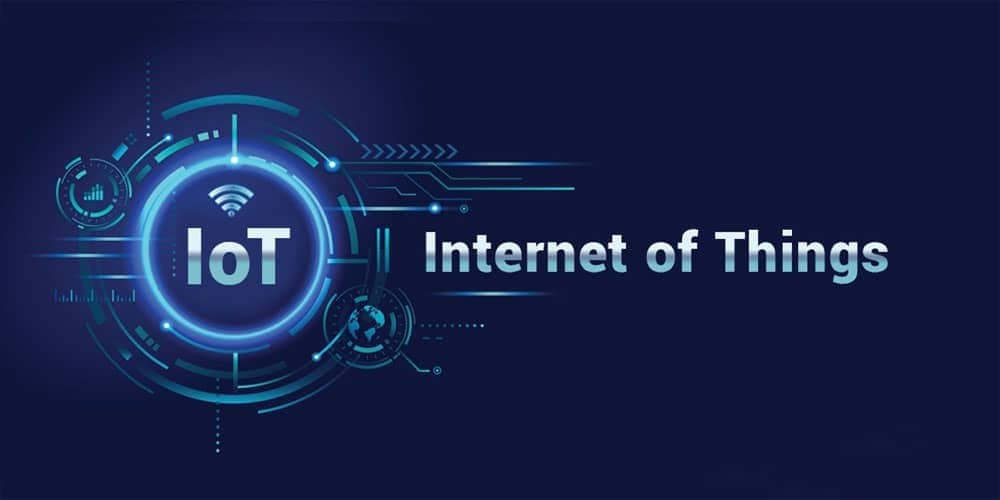
The Internet of Things (IoT) is a network that connects things and humans with multiple physical objects to communicate with each other, allowing them to transmit, receive, and exchange data via the Internet.
Therefore, things can have a conversation with everything around us, as long as they are connected to the Internet. Why do IoT devices need to share data? IoT devices across factories, humans, cities, offices, college campuses, hospitals, buildings, and vehicles collect our data and share them with other devices to provide us with a better, more comfortable, and more intelligent life experience, using a universal and unique language called data.
How does the Internet of Things (IoT) work?
IoT devices contain hardware, data, software, and connectivity. The hardware is a sensor that connects digital items to physical objects in order to sense things. Data makes sense of all this—every act that we make and every pattern that we take are collected in a universal language called data. We can say more with less. The software gathers data from the hardware to do things that are considered valuable to us.
The devices must be connected to the Internet. As the software collects the data, it will be analyzed locally or sent to the cloud to be analyzed. With the IoT applications, we can then interact. However, the main goal of the IoT is that the devices talk to other devices, without any human interaction.
Why is the Internet of Things (IoT) so important?
In the 21st century, the IoT plays a significant role in our daily lives. At first, the Internet was created by people for people and about people. It was the Internet of people. However, over the past few years, the Internet connects people, as well as things. Therefore, it is the Internet of Things.
Benefits of the Internet of Things (IoT)
The IoT provides a more intelligent and quantifiable environment, home, and workplace. IoT applications will be seen in both business and daily life. As the IoT clock rings in the morning, the IoT devices start to talk to each other. Your coffee machine makes a cup of coffee, the curtains open wide, and a chain of events starts to occur. They notify you how polluted and crowded the environment is, and which road to take to get to work on time.
Benefits include:
- Cost-effective
- Highly-availability resource
- Almost no learning curve
- Everything digital
- Universal connectivity
- Energy saving
Internet of Things (IoT) security issues
In October 2016, a hacker connected all digital video recorders and made them attack websites. Nearly 300 thousand IoT digital video recorders started attacking various social networks, such as Facebook, Twitter, etc. They took it offline.
Additionally, speaking child dolls can connect to smartphones via Bluetooth. The dolls listen to your child and respond to them, and if a child says any swear word, the doll avoids talking until the child’s parents speak to them. As the doll connects to your smartphone with no security pin, everyone around your home can connect to the doll and spy on your child. It's safe but also creepy, so a German privacy lawyer successfully got the doll banned.
As all IoT devices connect to the Internet, many IoT devices need your personal information. They have access to all your data, so they are not just your IoT—they are everyone's IoT. Ken Munro shows us how insecure IoT devices are. See more
History of the Internet of Things (IoT)
The history of the IoT dates back to 1999 with Kevin Ashton, a pioneer of technology who co-founded the Auto-ID Center at the Massachusetts Institute of Technology. A global standard system for RFID and other sensors was created. In a presentation that he made to Procter & Gamble, Ashton first mentioned the IoT.
The main concept was discussed in 1982 when a modified Coca-Cola vending machine at Carnegie Mellon University was able to report its inventory and whether newly loaded drinks were cold or not.
What is the Industrial Internet of Things (IIoT)?
The fourth industrial revolution or Industry 4.0 refers to turning data into real-time information. The main difference between IIoT and IoT is that the Industrial Internet of Things (IIoT) connects machines and devices in industries. In IIoT, you receive data in real-time, and can be obtained on demand as well.
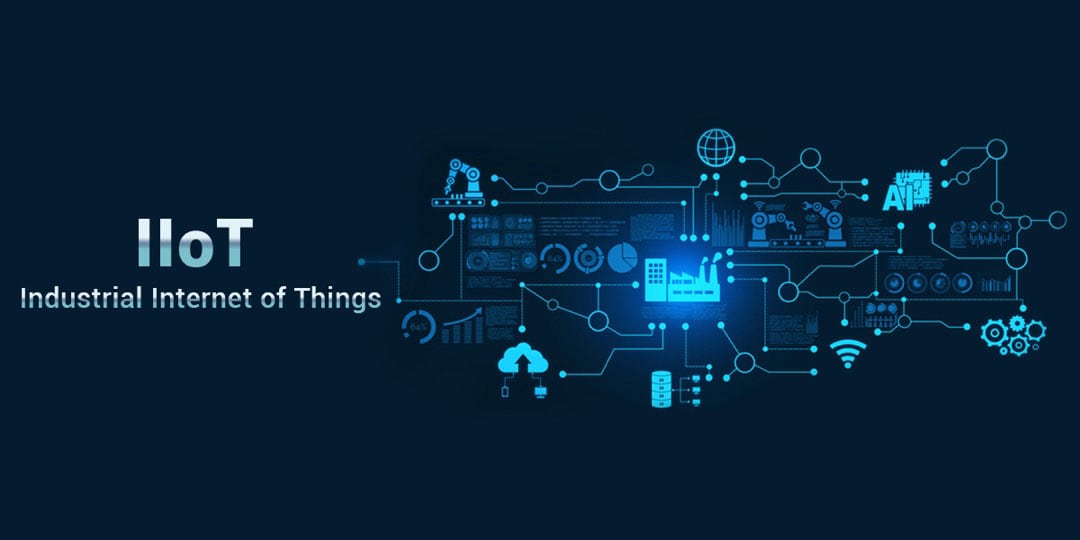
The IIoT depends on technologies:
- Artificial intelligence (AI) refers to machines that are sophisticated to act and respond like humans.
- Machine learning (ML) refers to machines that learn human behavior without programming.
- Cybersecurity technology makes a platform for disconnected machines and devices to physically connect by wire and communicate in a very safe and secure way.
- Cloud computing utilizes IT services to upload and download from Internet-based servers.
- Edge computing is a distributed computing model that optimizes machines and devices, bringing computing and data storage closer to each other.
- Data mining collects and examines extensive data stored from various parts of the enterprise.
Examples of IoT devices
Some examples of IoT devices that we see in our daily lives include:
Connected cars
When cars are connected to the Internet, the data will be collected and stored to prevent future failures or faults and predict vehicle maintenance needs. When a car crash happens, it will notify your family or friends.
Smart buildings
In order to have smart cities, we need to have smart buildings or building automation. This includes joining all of a facility's systems into a centrally controlled IP network with organized cabling. Smart building benefits include:
- Improved safety and security
- Decreased labor and operating costs
- Simplified asset management
- Energy efficiency
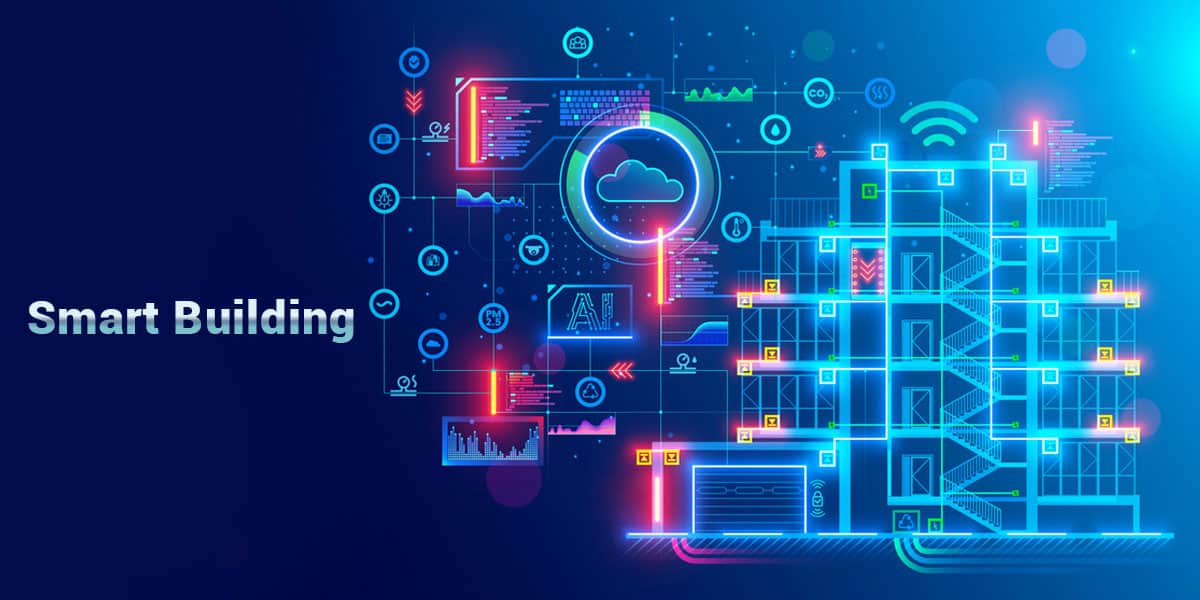
Fortune Business Insights estimates that the global smart building market is projected to grow from $80.62 billion in 2022 to $328.62 billion by 2029, at a CAGR of 22.2% in the forecast period. This can be seen through increasing requests for energy-efficient systems, the developing requirement for security systems, and the headway of IoT in Building Automation Systems (BAS). As we see the growth of 5G technology, we expect to create many opportunities for the growth of the global smart building market.
Building Automation with PoE Application
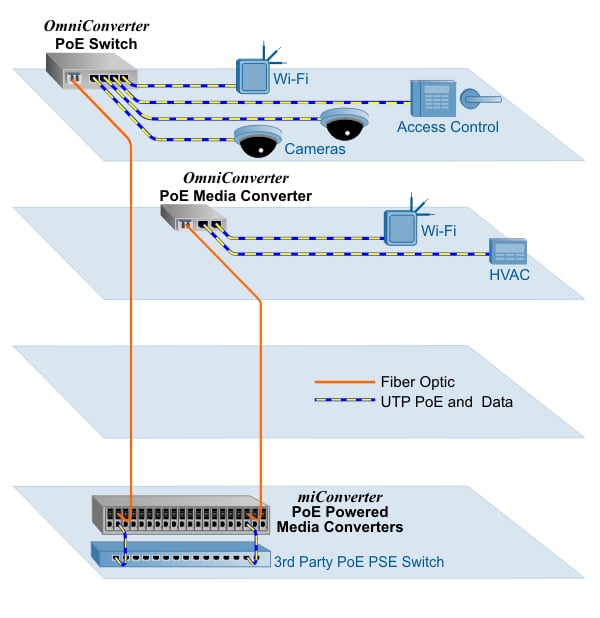
In this building automation application, the distance from the server room to devices is more than 100 meters, a distance limitation of UTP copper cabling. By utilizing fiber optic cables with OmniConverter PoE Media Converters and OmniConverter PoE Fiber Switches that have fiber uplink ports, the distance extension will be possible.
At the server room on the ground floor, a PSE PoE switch is deployed to provide network connectivity and power to local devices with copper UTP connectivity.
On one hand, the PoE switch powers the PoE-powered media converters and chassis, which provide cost-effective copper and fiber optic cabling integration. On the other hand, the miConverter 18-Module Chassis provides AC power to the PoE-powered media converters.
The copper is converted to fiber, and multiple fiber optic cables run throughout the different parts of the building, where PoE Media Converters and PoE Fiber Switches are located near AC or DC power sources. Fiber optic cables connect to the OmniConverter PoE Fiber Switch that powers PoE-powered IoT devices and up to eight PoE, PoE+,HPoE or PoE++ devices.
Smart city
Smart cities are designed to embed IoT in infrastructure, traffic lights, lamp posts, emergency alert systems, emergency services, hospitals, security surveillance, etc. This smart city design will be cost-effective, as long as things are connected to each other and to the Internet (IoT) to transmit data wirelessly in this ubiquitous communication of 4G/5G narrowband IoT.
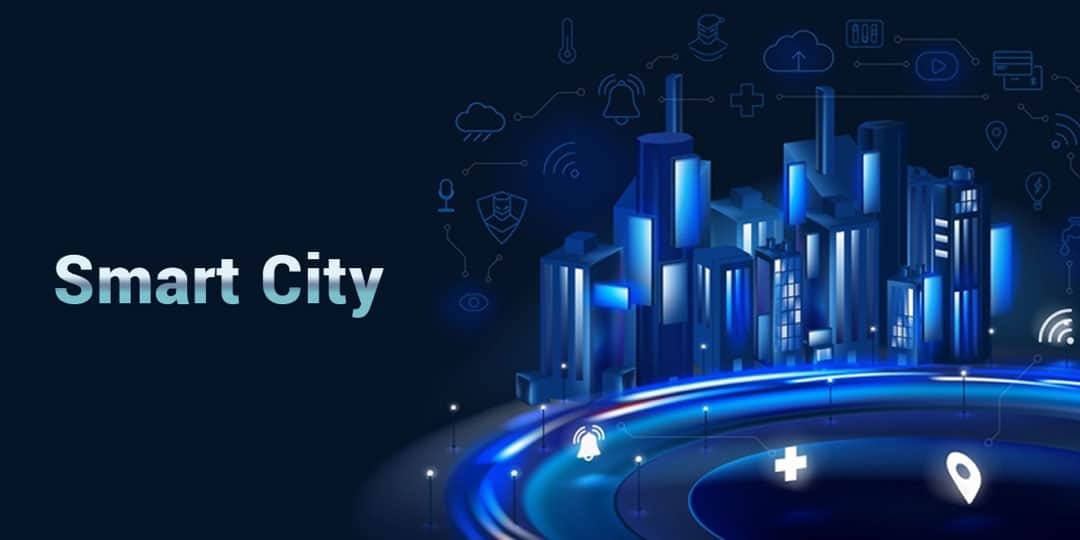
The benefits of network switches in smart cities
Network switches, including PoE Media Converters, PoE Fiber Switches, and PoE Extenders, can provide power to PoE-powered IoT devices and up to eight PoE, PoE+, HPoE or PoE++ devices. These can be used in smart building infrastructure to create smart cities. In order to have a smart city, every object or thing should be smart, including buildings, traffic management, street lighting, parking, etc.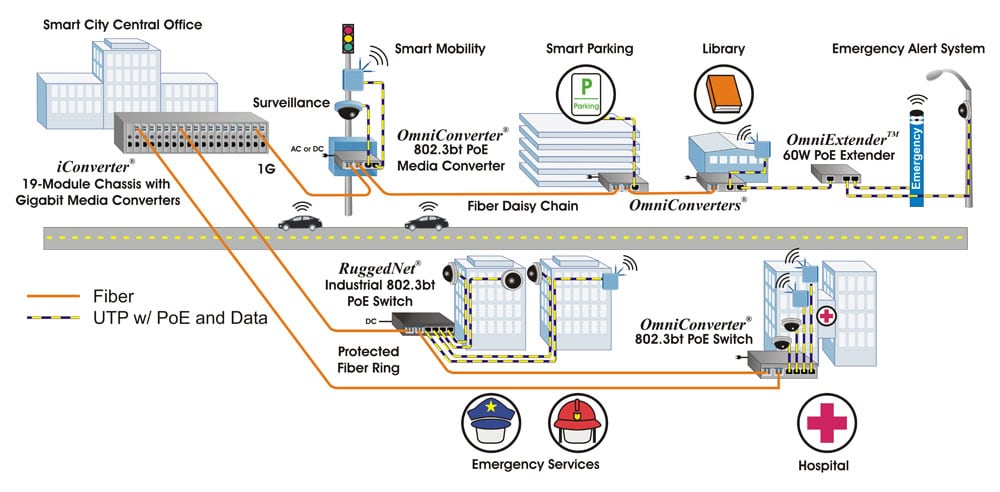
In the smart city application above, as all the buildings are smart and IoT devices are embedded in the city infrastructure with PoE Media Converters, the fiber is daisy-chained from one location to the next. It is used to connect surveillance cameras, smart mobility, Wi-Fi access points, and smart parking systems.
On the other hand, the PoE Extender is used to connect emergency alert systems, located just outside the 100-meter distance limit of copper cabling. The Industrial PoE switches are ruggedized switches. Their operating temperature ranges between -40 ºC and 75 ºC, so they are perfect to be used outdoors in extreme and harsh environments or in a ruggedized compact enclosure to power PTZ cameras and power-hungry Wi-Fi access points.
Hospitals and emergency services are connected to the city network with a protected fiber ring. So, the fiber is distributed from a smart city central office with a chassis of iConverter copper to fiber media converters to various locations within the city network. The PoE extender outside of the library is used to connect emergency alert systems located just outside the 100-meter distance limit of copper UTP cabling.
All PoE Media Converters, PoE switches, and PoE Extenders enable the easy installation of Wi-Fi access points, security cameras, and other PoE-powered IoT devices.
Industrial managed PoE switches, and OmniConverter managed PoE switches support IEC 62439-2 Media Redundancy Protocol (MRP) and IEEE 802.1w Rapid Spanning Tree Protocol (RSTP), which allows the smart city network manager to run protected fiber rings to minimize potential downtime.
Top smart cities in the world in 2022
According to Jupiter research, these are the 5 top smart cities in the world:
- Shanghai
- Seoul
- Barcelona
- Beijing
- New York
In the last few years, IoT devices have played a significant role in the edge of smart cities to decrease labor and operating costs and increase energy efficiency. With the help of network switches and Omnitron solutions and applications, safety and security are improved. As we move forward to a brighter and smarter future, we see more communication between IoT devices and switches to create smarter cities, buildings, and environments.
Conclusion
IoT embeds with humans, giving us a chance to save our time, but it never prompts laziness. It allows us to be more innovative to create a better and smarter life. Never forget the purpose of IoT technologies. As Mark Weiser wrote in an article in 1999, "The most profound technologies are those that disappear. They weave themselves into the fabric of everyday life until they are indistinguishable from it." IoT is just like this. Read more about Omnitron systems solutions and applications.
Resources:
https://www.youtube.com/watch?v=mzy84Vb_Gxk&t=320s
https://www.youtube.com/watch?v=vgoX_m6Mkko
https://internetofthingsagenda.techtarget.com/definition/Internet-of-Things-IoT
https://www.oracle.com/internet-of-things/what-is-iot/
https://en.wikipedia.org/wiki/Internet_of_things
https://aws.amazon.com/what-is/iot/
https://www.zdnet.com/article/what-is-the-internet-of-things-everything-you-need-to-know-about-the-iot-right-now/
https://builtin.com/internet-things
https://www.omnitron-systems.com/solutions/poe-building-automation-smart-buildings
https://www.omnitron-systems.com/solutions-by-industry/smart-city









